Lord Rama principles (precepts) (Ramarajya meaning) | Why Rama’s period was known as Ramarajyam
Namaste friends, how are you doing today? Welcome to #BhagavanBhakthi website / blog.
Bhagavan Lord Sri Vishnu blessings to you and your family!
In this website / blog, you will always learn about #Hinduism #Sanskrit language.
Also subscribe to my YouTube channel from this link #BhagavanBhakthi to view videos about #Hinduism #Sanskrit language.
Just before going to “Lord Rama principles (precepts) (Ramarajya meaning) | Why Rama’s period was known as Ramarajyam“, let us know a brief, basic and very important information.
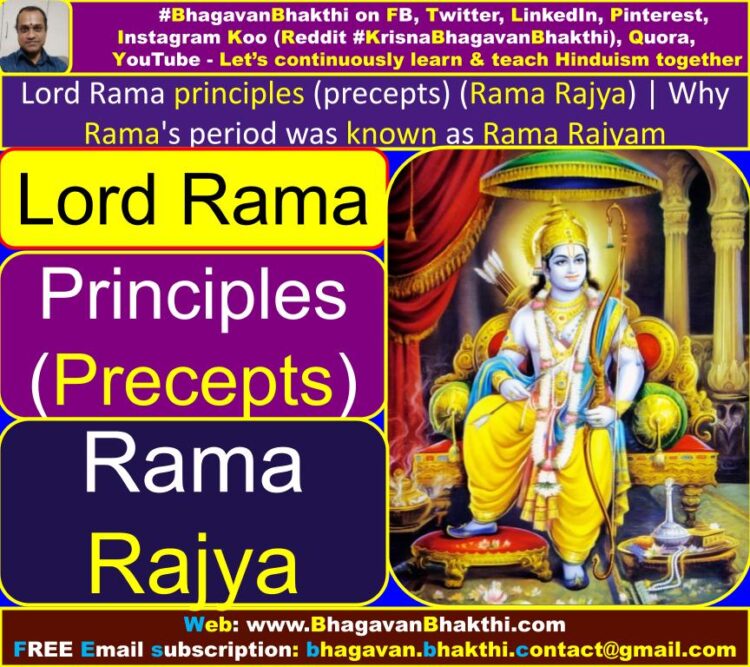
Lord Sri Rama’s father name is Dasharatha, mother name is Kausalya Devi.
Dasharatha had three wives, in that Kausalya Devi was the eldest, second was Sumitra Devi and third was Kaikeyi Devi.
Lakshmana and Shatrughna’s mother was Sumitra Devi and whereas Bharata’s mother was Kaikeya Devi.
First son was Rama, second was Lakshmana, third was Bharata and fourth was Shatrughna.
Dasharatha was the king of Kosala and it’s capital was Ayodhya.
Now, let’s move to “List of Lord Rama principles (precepts) (kartavyas) as a king“:
Sri Rama had once taught Lakshmana about the principles / precepts / kartavyas (duties) of a Raja.
List of Lord Rama principles (precepts) (Ramarajya meaning) as a king are as given below:
Why Rama’s period was known as Rama rajyam?
1. Earn wealth : Firstly, as a king, he has to earn sattvik (right way – as per Dharma) wealth.
2. Increase wealth : Secondly, he has to increase it in the right way (Dharmic).
3. Protect wealth : Thirdly, he has to protect it, and
4. Donate wealth : Fourthly and finally, he has to donate it to the right people (needy) at the right time.
5. Should have Adequate wealth : As a Raja one should be having adequate amount of wealth otherwise it will be difficult for the smooth running of the nation.
6. Wealth segregation in Dharmic way : Also it should be kept in dhyanam (mind) that the wealth segregation should be in the Dharmic (correct) manner, that is,
it should be done according to the Sanatana Dharmatva (as per instructions given in the Sanatana Dharma).
7. No force segregation : No Raja (King) should segregate money by force or by giving pain to his subjects, to his people.
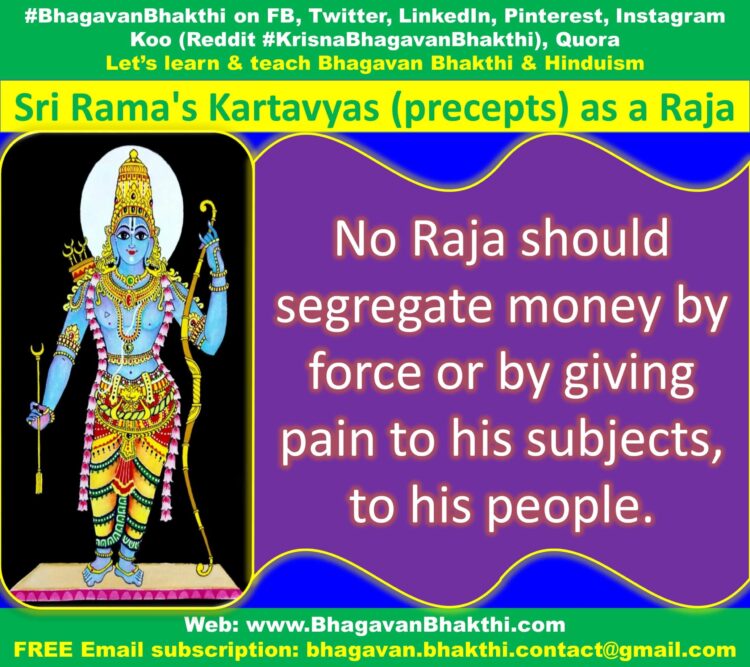
8. A Raja should be good mannered : A Raja (King) should be neetivanta (good mannered).
9. Protect wealth properly : A Raja (King) should protect the wealth properly.
10. Raja should foresee problems : A Raja (King) should foresee the problems, that is,
about his enemies. If an enemy attacks the Raja / nation for the same wealth, then the Raja should be capable of defending it.
11. Raja should safeguard wealth : A Raja should be able to safeguard his wealth, otherwise the enemy will easily enter into the house and will steal all the wealth and will get away easily.
12. Raja should be wise : A Raja should be wise enough to save and safeguard the wealth.
13. Wealth should be donated to needy : Mainly a Raja should donate the same wealth to his subjects,
to his people, to his beloved, to the needy, to the poor, otherwise what is the use of segregating so much of money.
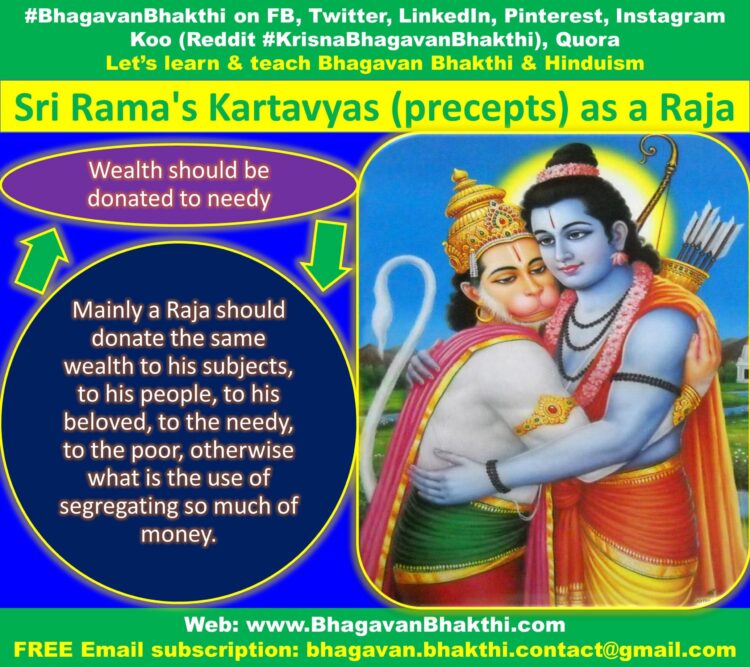
14. Should have adequate amount of money when in need : A Raja should be ready with adequate amount of money when his rajyam (nation) is in bad condition, that is:
when his rajyam may hit by some natural calamity.
15. Look after the subjects with required things : Then at that situation the Raja should be having enough money, wealth,
so that he can look after his subjects by donating food, clothes, water, shelter, medicines and other required things.
16. Raja shouldn’t be apathetic : No use of Raja if he is apathetic, otherwise what is the use of a Raja if he doesn’t takes care of his own people, his own subjects.
17. Raja should have conquered his senses (Indriyas) : A Raja must also be susamkruta (polite) and must be of shishttacharyavaadi (well mannered) which comes through the jayam (conquer) of the indriyas (senses).
18. Raja must have namrata (humbleness) : A Raja must be of namrata (humble) swabhava-vaadi. The indriyas (senses) are like mad gajas (elephants).
Indriyas can move anywhere at any time and thus, a Raja should have a great namrata (humbleness).
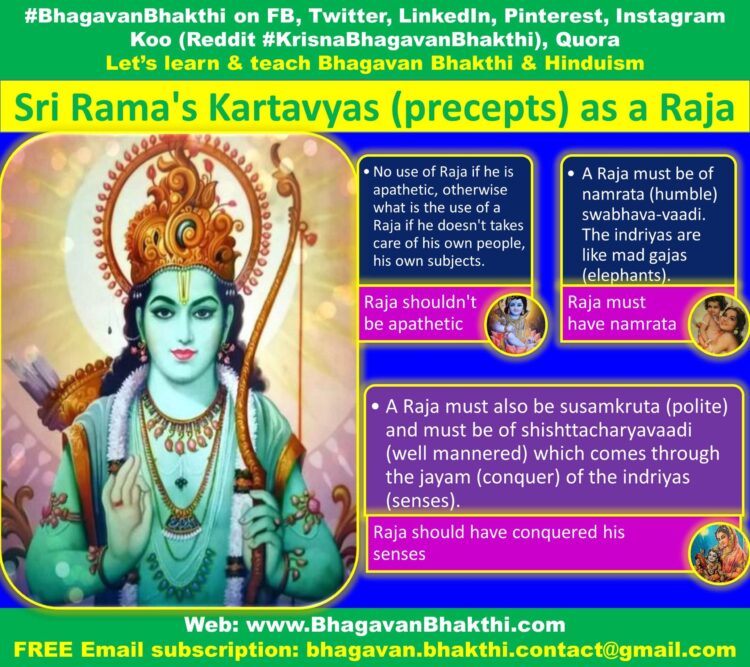
19. Indriyas shouldn’t be pampered : If the indriyas are pampered, like mad gajas (elephants), they trample shisttacharyas (well mannered) and namrata (humility) underfoot.
20. Raja should be free from ego : A Raja should not have any ahankaara (ego / arrogance).
If he has ahankaara or aham then a Raja will lose his indriyas and won’t be able to take correct decisions.
21. Egoistic Raja can’t be righteous : A single elephant is not good for a rajyam or to the subjects of the Raja or to the poor.
A ahankaaravaadi (highly egoistic) Raja would never be a confident person.
That Raja cannot be a dharmishtta (righteous person).
22. Raja should be non-violent : A Raja must also be ahimsaavaadi (non-violent), satyabhushana (truthful person), shuddhha (clean) and kshamavaadi (forgiving).
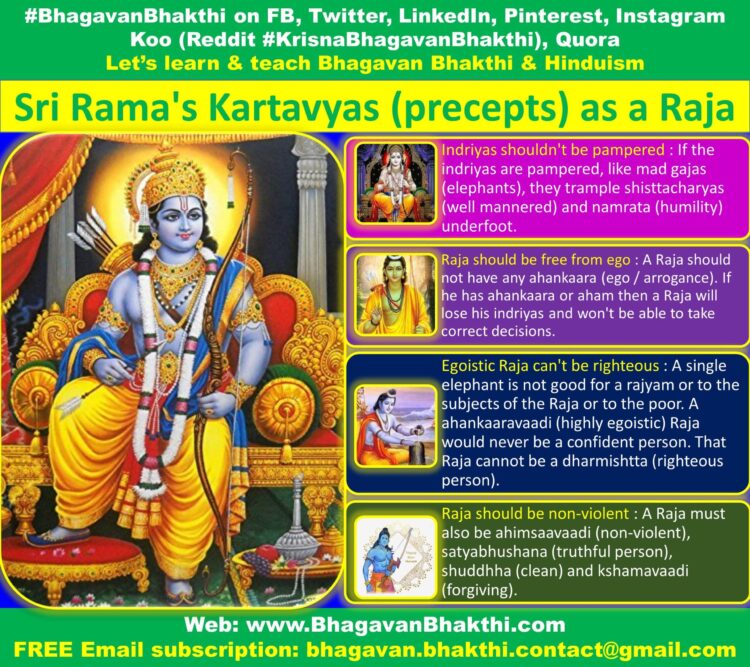
23. Raja should take care of rituals : He should take care to observe all the aacharanas (rituals).
24. Raja should provide food : He should give annam (food) to those who are poor and needy.
25. Raja must protect protection seekers : He should protect those who seek rajya rakshana (royal protection).
26. Raja should use pleasant words : He should always use shabdaas (words) that are pleasant to hear.
27. Unhappy people curse is enough to bring down a Raja : The body is here today and tomorrow it will vanish.
Stupid is the king who deviates from the path of dharma (righteousness) to give pleasure to a body that is transient.
The curses of unhappy people are enough to bring down even a Great Raja.
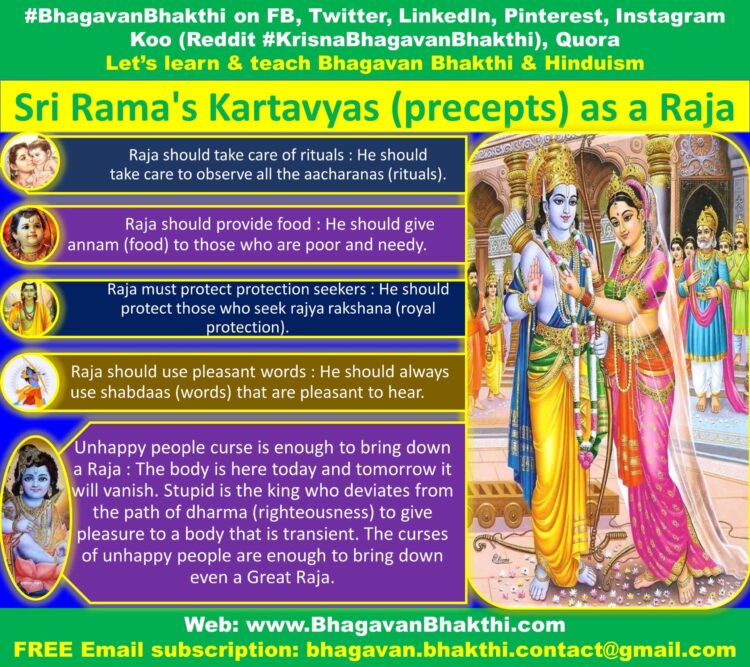
28. Difference between Devatas (Demigods) and Asuras (Demons) :
There is only one difference between Devas (Gods) and asuras (demons).
Devas use pleasant words, while asuras (demons / inhuman people) use rough words.
The Raja must use pleasant shabdaas (words) like a Devata.
And he must use pleasant shabdaas not only for those who are his friends or who are good, but also, for those who are his shatrus (enemies) or are dushttas (evil).
29. Pleasing qualities of Raja : With obeisance a Raja pleases his Guru, with good behavior the Dharma, with kartavyas (duties) the Devatas,
with prema (love and affection) to the sevakas (servants) and with alms those who are inferior, poor and needy.
30. Kingdom has sapta ghatakas (seven components) : The kingdom has sapta (seven) ghatakas (components). These are the Raja,
the Mantries (ministers), the Mitras (friends), the Khajaanavaadi (treasurer), the Sainya (army), the Forts and the Desham (country/state) itself.
Of these, the most important is the Desham and it has to be preserved at all costs.
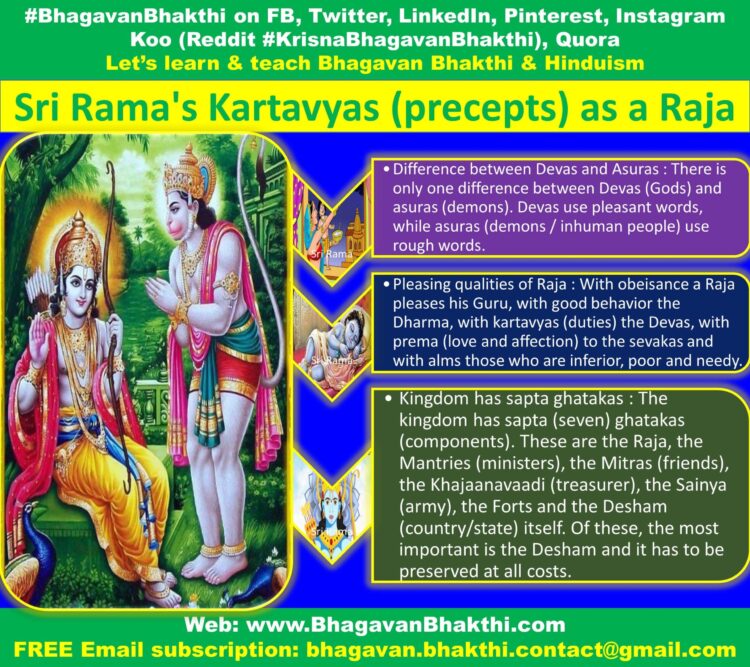
31. Raja must be extremely careful choosing ministers : A Raja must be extremely careful in the choice of the Mantries (ministers) and the Rajya guru (royal Guru).
The raja must not choose or consult Mantries who are stupid or idiots or bhrashttacharis (corrupted) people.
32. Raja’s signs : A Raja’s swabhavas (signs) are his golden rod or scepter and an umbrella that is held over his head in the ratha (chariot).
The umbrella should be made of the feathers of pakshis (birds) like hamsas (swans), peacocks or cranes,
but the feathers of different types of pakshis (birds) should not be mixed in the same umbrella.
33. Qualities of throne of Raja : The simhaasana (throne) should be made of wood and should be embellished with svarna (gold).
34. Bow qualities : A bow can be made of iron, horn or wood. The best bow is one that extends over four arm lengths.
35. Usage of tax money : A Raja can spend up to one year’s tax revenue on armaments and flags.
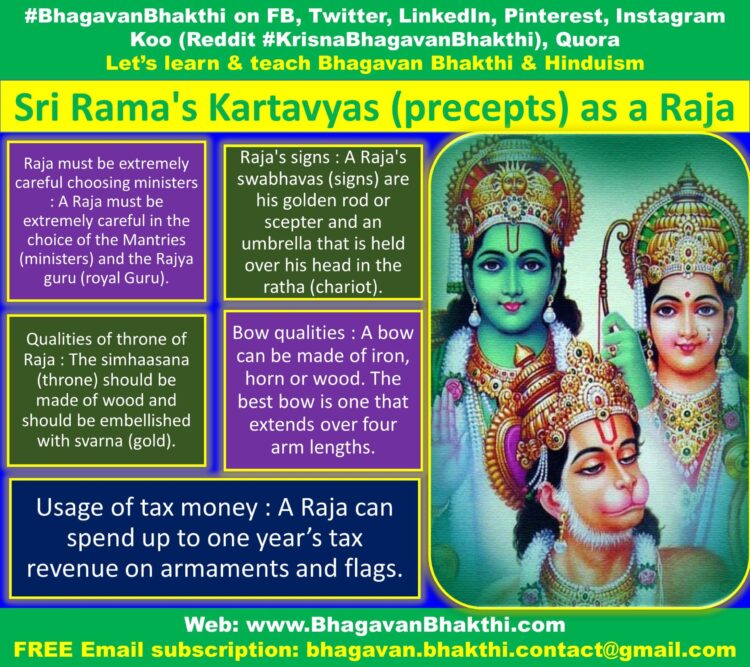
These are very few Kartavyas / principles (precepts) of a Dharmic Raja.
That’s why our Sri Rama Chandra Prabhu is the Greatest of the Greatest.
No one can match Sri Rama’s Dharmic duties. Thus Sri Rama’s period was known as “Sri Rama Rajyam”.
More information will be added to this on regular, please visit after some time to know more information.
To watch videos on #Hinduism #Sanskrit language, SUBSCRIBE to my YouTube channel from this below link:
#BhagavanBhakthi YouTube channel
To know more about “Lord Rama unknown facts“, please click the below link:
Dear friends, if you need any clarifications about this post, kindly let me know, I will definitely try to answer all of them.
Also your one LIKE, one COMMENT, One Share, one SUBSCRIPTION is highly important.
This will help to know the quality of this content and also it will be helpful to know if any improvements is required for the content.
If you feel this content is useful to you and has helped you to improve your knowledge, kindly share this with your well-wishers.
Because “SHARING MEANS CARING”.
To receive FREE EMAIL SUBSCRIPTION about #BhagavanBhakthi, you can send an email to bhagavan.bhakthi.contact@gmail.com from your email ID.
NAMASTE!
Sri Gurubhyo namaha
Sri Sita Raamaaya namaha
Sri Krishnaarpanamastu